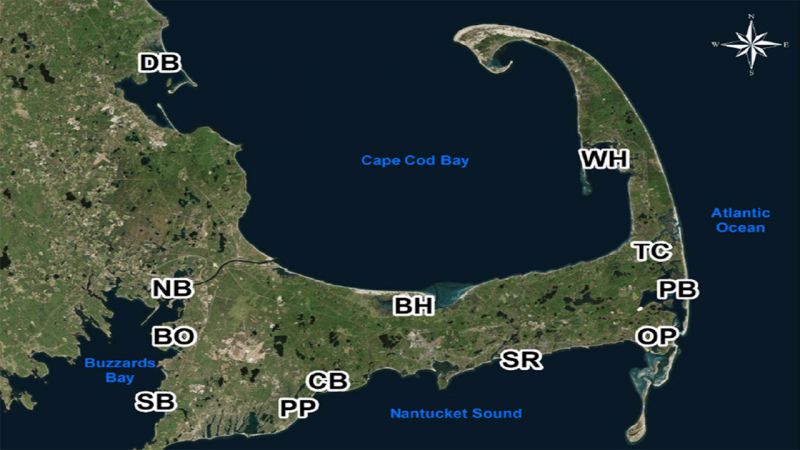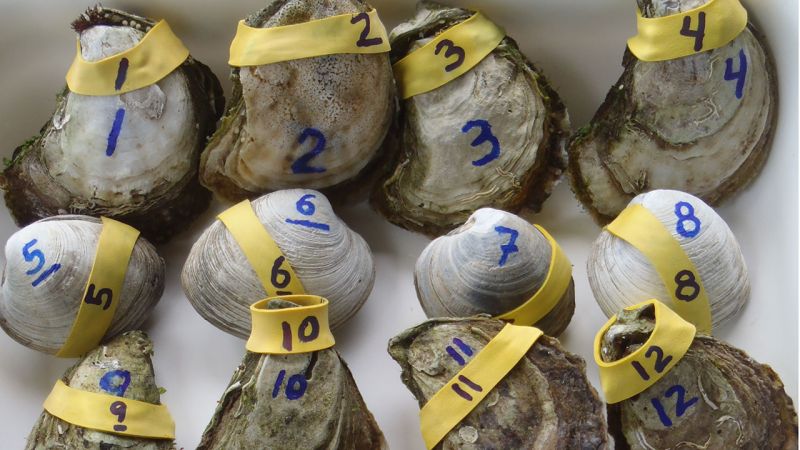First Measurement of Nitrogen Removal by Local Shellfish
Published on by Water Network Research, Official research team of The Water Network in Academic
Towns along Cape Cod and the Islands are looking to shellfish not only as tasty culinary treats, but also for help cleaning up waters degraded by excess nitrogen in the region.

Map of shellfish sampling sites: Duxbury Bay (DB), North Buzzards Bay (NB), Bourne Harbors (BO), South Buzzards Bay (SB), Popponesset Bay (PB), Cotuit Bay (CB), Swan River (SR), Oyster Pond (OP), Pleasant Bay (PB), Town Cove (TC), Wellfleet Harbor (WH), and Barnstable Harbor (BH). Credit: Woods Hole Oceanographic Institution
While nitrogen is essential for all plants and animals, too much nitrogen in ponds and waterways—often caused by fertilizer runoff and septic tanks—can fuel algae growth, and cause low oxygen levels.
Shellfish, such as oysters and quahogs, are efficient filter feeders that help remove excess nitrogen by incorporating it into their shells and tissue as they grow. But exactly how much nitrogen they're capable of removing in local waterways and how those amounts might vary by location or season has been unknown due to lack of region-specific data.
A new study by Woods Hole Sea Grant, Cape Cod Cooperative Extension, and the Mashpee Department of Natural Resources provides the first comprehensive measurement of nitrogen removed by shellfish harvested from waters off Cape Cod.
"We did this project specifically as a service to local municipalities to get them accurate data to utilize, if they're going to go with the approach of seeding and growing shellfish as part of their water quality management plans," says Woods Hole Sea Grant Extension Agent Joshua Reitsma, lead author of the paper published online Jan. 10, 2017, in the journal Marine Pollution Bulletin.
The NOAA-funded Woods Hole Sea Grant program, based at the Woods Hole Oceanographic Institution, supports research, education, and extension projects that encourage environmental stewardship, long-term economic development, and responsible use of the nation's coastal and ocean resources.
During fieldwork in 2012, the research team gathered samples of both wild and farmed oysters (Crassostrea virginica) and quahogs (Mercenaria mercenaria) from various water bodies in the Cape Cod region (see accompanying map for sample sites). The samples were then analyzed for nitrogen stored in the shells and tissues, which represents how much nitrogen would be removed from the water when harvested.
On average, the researchers found individual oysters contained .28 grams of nitrogen, slightly more than the average quahog with .22 grams. Wild oysters and those grown on pond bottoms contained an average of .32 grams of nitrogen—more than those grown in floating cages.

Samples of wild and farmed oysters (Crassostrea virginica ) and quahogs (Mercenaria mercenaria) from various water bodies in the Cape Cod region were analyzed for nitrogen stored in the shells and tissues. Credit: Diane Murphy, Woods Hole Sea Grant
"Wild oysters or bottom-grown oysters, which deal more with predators, have to grow thicker shells for protection," Reitsma explains. "More shell means greater weight, and with greater weight, the animal can take in more nitrogen."
The nitrogen values also varied by season, with shellfish harvested in the fall taking in more nitrogen, which Reitsma says wasn't a surprise since oysters and quahogs tend to "fatten up" in the fall in preparation for the winter season.
"Theoretically, you could maximize the amount of nitrogen removed by harvesting in the fall rather than in the spring, when the shellfish tend to be skinnier," he adds.
There's also the added benefit that shellfish aquaculture generates economic activity as well. While shellfish are a valuable and effective tool as the study points out, the researchers stress that they should be considered just one part of the long-term solution for reducing nitrogen in waterways.
Read more: Phys.org
Media
Taxonomy
- Aquaculture
- Aquatic Ecology
- Aquaculture Systems
- Treatment
- Biological Treatment
- Contaminant Removal
- Marine
- Aquatic Environment
- Oceanographic Survey
- Pollution